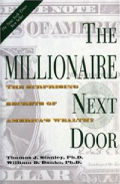[separator top=”15″]
[one_fifth last=”no”]

[/one_fifth]
[four_fifth last=”yes”]
Thomas J Stanley and William D Danko have done a huge amount of research to determine the characteristics of today’s millionaires. The biggest surprise for most readers is that those we “thought” were the wealthy (expensive homes, luxury cars, exotic vacations) are not necessarily the ones who are financially free.
Another big revelation for me was the concept of “Economic Outpatient Care” – the gifting of economic support to our children, with the idea of helping, which actually creates dependency and a tendency to overspend.
[/four_fifth]
[separator top=”15″]
[separator top=”-10″]
| 80% of America's millionaires are first generation rich Common Attributes • businessman who has lived in the same town all his adult life • married once, remains married • lives next door to people with a fraction of his wealth • compulsive saver and investor • made his money on his own • confident in their own abilities Seven Common Denominators 1. live well below their means 2. allocate their time, energy, and money efficiently, in ways conducive to building wealth 3. believe that financial independence is more important than displaying high social status 4. parents did not provide economic outpatient care 5. adult children are economically self-sufficient 6. proficient at targeting market opportunities 7. chose the right occupation Definitions of Wealthy = people with an abundance of material possessions (Webster) = net worth of $1M or more (assets – liabilities) = can sustain lifestyle without income for a long time Formula for determining wealth... Your Net Worth = (Your Age x Pre-Tax realized annual household income) / 10 (don't count your inherited wealth in your annual income or net worth) PAW = prodigious accumulator of wealth (top quartile) AAW = average accumulator of wealth UAW = under-accumulator of wealth (bottom quartile) PAWs = the best at building net worth compared to others in their income/age category (typically have 4x the wealth of UAWs) UAWs = live above their means, emphasize consumption (it takes more money to maintain the upper middle class lifestyle than a middle class or blue-collar lifestyle) Frugality translates into wealth. Most expensive suit? <$399 (50%), <$285 (25%) JC Penney's Stafford Executive = durability, cut, fit Most expensive footwear? <$140 (50%), <$100 (25%) Most expensive wristwatch? <$235 (50%), <$100 (25%) New (63%) vs Used (37%) buyers Car "shoppers" are patient, compare prices, wait for a deal. Dealer loyalists generally have a business relationship w/owner. Not affluent? People spend tomorrow's cash today. (debt-prone) Frugality related to frugal upbringing, supportive (frugal) spouse = both Offense (earning power) and Defense (spending restraint) Auctioneers (35% are millionaires) Why? 1) experience with bankruptcy (witness repercussions) 2) hold appreciating assets (in areas of expertise) 3) spend less on housing (61% of urban/suburban millionaires) 4) 3x less likely to own luxury foreign automobiles | BUDGET - Like joggers who run, the wealthy stay financially fit. Most budget. Those who don't create an artificial economic environment of scarcity (invest first, spend the balance). 2/3 know how much family spends on food, clothing, & shelter (35% of high income non-millionaires don't know) Credit Cards? Visa and M/C (56-59%), Sears (43%), Penney's (30%) Financial Goals ~2/3 have clearly defined daily, weekly, monthly, annual, and lifetime goals, and plan for the future. The remaining 1/3 are retired, already met goals or inherited wealth. financial security >> happy Income Tax = largest annual expenditure (average American pays 10%, wealthy pay 2%) To build wealth, minimize your realized (taxable) income and maximize your unrealized income (wealth/capital appreciation without a cash flow). Wealthy < 7% of wealth is taxable. Invest in what you know about. Non-wealthy don't invest, they live paycheck to paycheck, earn to spend. When they spend more, they just earn more. Investment Planning + Controlling Consumption >> leads to increased wealth PAWs allocate 2x more hours per month to planning investments (~20 hours/month managing current investments) than do UAWs PAWs also allocate ~1 hour/mo to controlling consumption. Hire a financial advisor. Ask for references, college transcript, credit check, personal interviews, employment application, documents demonstrating their ability. Ask accountant or an accountant's clients for recommendations, or ask accounting professors (CPAs) for successful students (most work for a large accounting firm then start their own business). Economic Outpatient Care (EOS) = substantial economic gifts Parents who provide EOC have less accumulated wealth. Adults who receive EOC accumulate less, become high volume consumers, are less productive, take less initiative, spend gifts before they're received, are significantly more dependent on credit, and invest less (receivers = weakened children) "Teach your children to fish." Guidelines followed by the affluent with successful adult children 1. Never tell children that their parents are wealthy. 2. Teach your children discipline and frugality. 3. Assure that your children won't realize that you're affluent until after they have established a mature, disciplined, adult lifestyle and profession 4. Minimize discussions about inheritance or future gifts. 5. Never give cash or other significant gifts as a coercion tactic. 6. Stay out of your adult children's family matters. 7. Don't try to compete with your children. $$ is not the goal. 8. Children differ in motivation and achievement. Subsidizing underachievers tends to enhance differences in wealth. 9. Teach your children to achieve, not just to consume. 10. Tell your children many things are more valuable than money. |
